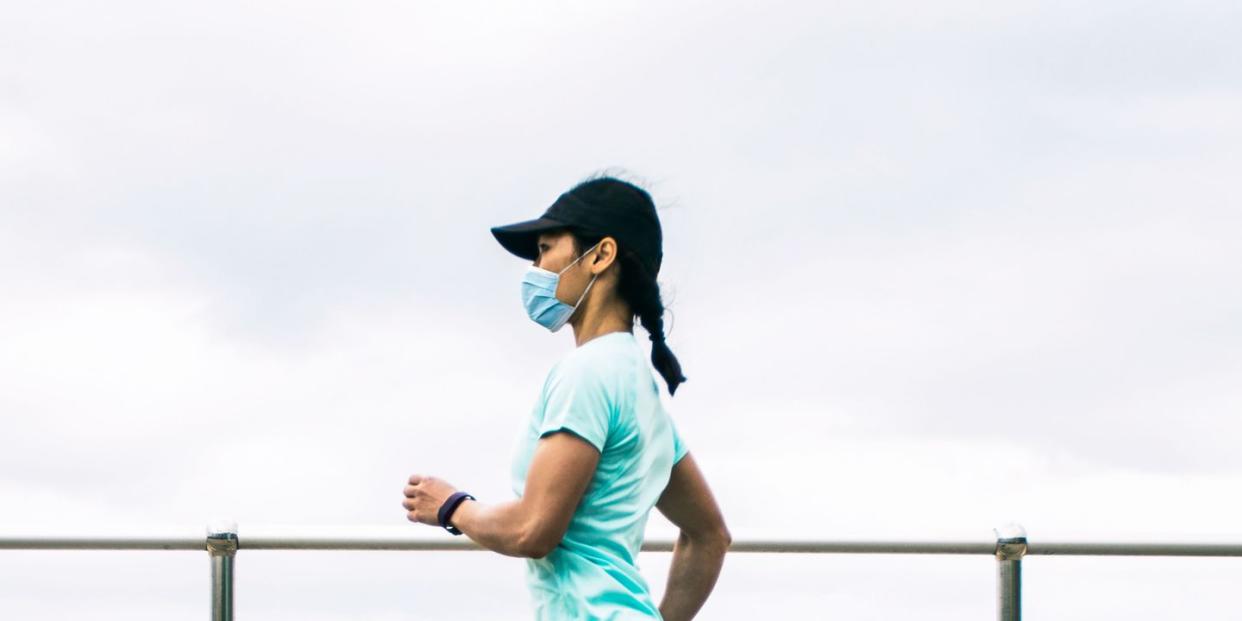This Is What Running In A Face Mask Does To Your Skin

It’s safe to say that COVID-19 has disrupted all aspects of regular life: The office has been replaced by a makeshift work-from-home set-up, happy hour is now held virtually on Zoom, and your go-to workout routine has moved from the gym to your living room. Luckily, there’s some good news: According to the CDC, it’s still okay to go for a walk or run outside as long as you stay six feet away from others.
While a sweat session in the fresh air certainly sounds appealing, it’s imperative to take the proper precautions. That’s why if there’s a chance you’ll encounter others during your workout, you should be wearing a face mask.
"This is especially important if you're outside in a crowded area, particularly city sidewalks, a mask may be both reassuring to others as well as within the guidelines set forth by your local government,” explains physician Christina Sensabaugh, MD.
This falls in line with the CDC’s recommendation to “wear a cloth face covering in public settings where other social distancing measures are difficult to maintain, especially in areas of significant community-based transmission.” Basically, if you live in a metropolitan area, get into the habit of masking up before putting on your running shoes.
Now that you know whether or not you need to wear a mask while running, you might wonder what that means for your skin.
Your skin will likely become irritated in one form or another.
“One good thing about wearing a face mask outdoors is that it helps to shield a significant portion of your face from the sun but wearing one can also lead to some skin problems,” adds dermatologist, Allison Arthur, MD. “Friction from the mask rubbing repeatedly on certain areas of the face can causes skin irritation or even raw, open sores.” Other not-so-great side effects include rosacea flare-ups that occur from trapping hot, humid air against the skin and breakouts thanks to oil and sweat getting trapped in pores.
Choose a breathable material.
Like the rest of your running gear, it’s also important to pick a mask made out of the right material. “While synthetic materials may be more effective at filtering air, they’re also harsher on the skin. If you are outdoors and keeping your distance from others, a cotton mask may be a better option for your skin, because natural fibers like cotton are much gentler and less likely to harm the skin,” says Joshua Zeichner, MD, a dermatologist in NYC. If you’re DIY-ing a mask, consider using moisture-wicking materials that sports apparel is made of to minimize sweat and friction. Tempted to loosen up complexion-rubbing mask? Resist the urge. According to Dr. Zeichner, a face covering won’t be effective without direct contact with the skin since you need a tight seal to protect against infected air.
Prep your skin before and after your run.
Another way to prevent irritation is by using an ultra-gentle cleanser before and after your run like Dove’s Beauty Bar. “It cleanses the skin without compromising the integrity of the skin barrier itself,” says Dr. Zeichner. “And its cleansing molecules are the same types of hydrating ingredients found in traditional moisturizers.” He also suggests applying Vaseline’s Petroleum Jelly to any areas where the mask will come in direct contact with the skin to maintain hydration and reduce friction. “This is just like preparing for a marathon and preventing your shirt from rubbing on your skin leading to skin irritation,” he continues.
Other complexion saving tips? Skip wearing foundation and primer underneath your mask (no one will see you anyway!) and if you are experiencing a little inflammation, apply a hydrocolloid bandage on clean, dry skin before putting on your face covering. “This will promote healing and prevent further damage to the skin,” says Dr. Arthur. “And make sure that all exposed areas of skin not covered by the mask are protected with sunscreen.” After all, the last thing you want is irritated skin and a sun burn. Once you’ve wrapped your workout, cleanse skin and then apply a soothing moisturizer to repair and rehydrate the skin.
Treat breakouts with benzoyl peroxide.
If you notice that you’re starting to breakout around your mouth, Dr. Zeichner recommends trying a spot treatment that relies on benzoyl peroxide since it lowers levels of acne causing bacteria that thrive in oily environments and promote breakouts. “For example, Neutrogena’s On-The-Spot Acne Treatment with 2.5% benzoyl peroxide has been shown to be as effective as higher concentrations in treating inflamed pimples but causing less irritation,” he furthers. “Just make sure to wash off your face before putting a mask back on as benzoyl peroxide can bleach darkly colored fabrics.”
Only wear your mask once.
And keep in mind your face isn’t the only thing that needs cleansing after a sweaty run: “If you have a reusable fabric mask, it’s important wash that too, so that it doesn't become a reservoir of sweat, dirt, and oil,” explains Dr. Arthur since that will amplify any adverse skin conditions.
You Might Also Like

